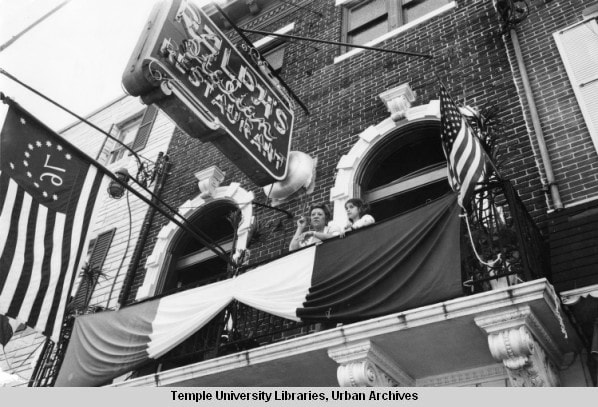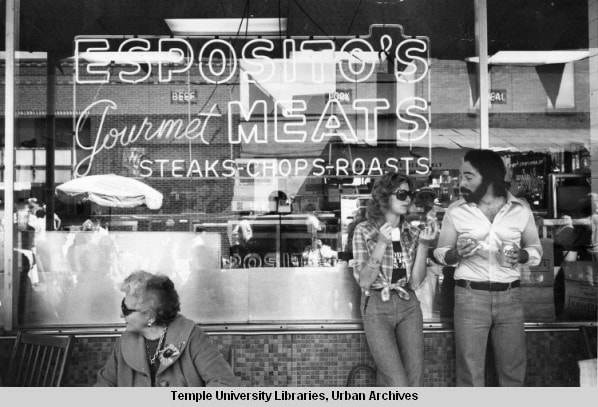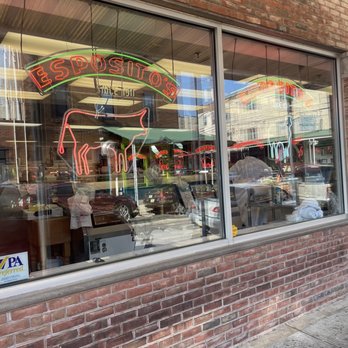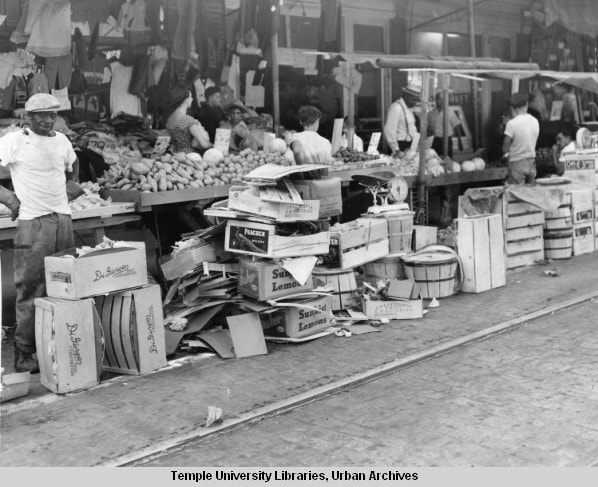Molly’s Books & Records: A Historical Account of the Bookstore in Bella Vista
Molly’s Books & Records is an independent bookstore in the Italian Market of South Philly, an area teeming with restaurants, butcheries, and cheese shops. The bookstore’s collection of cookbooks fits well into its diverse culinary surroundings. However, the store and its owner, Molly Russakoff, greatly predate the establishment of that section. To get the full picture, we need to start…
In the 1880s, when Italian immigrant Antonio Palumbo opened a boarding house in what we now know as the Bella Vista area (“History”). This Philadelphia neighborhood was a hot spot for Italian immigration, with tens of thousands of Italians moving there in the late 1800s and early 1900s (“The Italian”). With such a large number of Italian immigrants in one area, Palumbo’s business was only the first in a line of succeeding establishments that would contribute to the creation of the official Ninth Street Curbside Market. A historical account of the area suggests that “[f]oodways strengthened Italian identity”, an idea enforced by the immigrants’ creation of a market focusing on Italian cuisine. Curb markets were popular at this time because “[t]hey offered an immediate and economical outlet for food products and related merchandise” (Tangires). This helped residents combat food insecurity during WWI (“History”).
“Philadelphia’s working poor gathered to purchase their essentials, leaving the high-tone shopping districts of Center City to those with greater economic means”(Explorepahistory.com).
By the mid-1900s, people began to refer to the Ninth Street Market as the “Italian Market” due to the prominence of Italian businesses it hosted (Tangires). This name remains a common title for the area today. However, this large population of Italian residents would soon be joined by a variety of other immigrants following WWII. It was common with curbside markets for owners to live above their business (Explorepahistory.com). When this trend became obsolete and space freed up, a new wave of immigrants from various places moved in, creating a more diverse market space (Tangires). The first Korean-owned establishment opened in the neighborhood in 1983. This opening was followed by various other Asian and Mexican businesses. This influx of immigrants from different nationalities diversified the Bella Vista area. The market spread out from its initial base on 9th Street, and the neighborhood became even more rooted in the “immigrant experience” (Explorepahistory.com).
Old pictures of the Italian Market that reflect a popular, bustling food community. In one photo, there appear to be both Italian and American flags hanging off of buildings, representing the fusion of both cultures in the Italian Market.
The Pennsylvania Historical and Museums Commission dedicated a marker to the market in 2007 (“History”), which “certified a rich heritage but also reflected the curb market on Ninth Street as a tourist destination…” (Tangires). The market has fed into this idea, establishing a visitor center in 2012(“Change”). There has also been an increase in high-end businesses in the neighborhood, a reflection of this new audience that visits the market for recreation over necessity (“The Ninth”).
Today, Bella Vista boasts a vast array of food businesses from various backgrounds. Its Italian population has greatly diminished, but there are still many Italian businesses that remain a part of the area (“Change”). The contemporary Italian Market serves as a cultural hub of independent businesses centered around global cuisine (Tangires).
“Diversity became a key feature said to distinguish the independents from chain booksellers” (Miller 84).
This development of the Italian Market has created a wide audience of both regular customers and passing tourists that benefit all businesses in the neighborhood, including Molly’s Books & Records (“Molly’s”).
The store’s founder, Molly Russakoff, has lived in the Italian Market area for around 43 years (DeMuro). She is a third-generation bookseller and a poet, so she has deep ties to the literary world. Molly did not purchase the land for the store until 2000. She has opened and subsequently closed various businesses on this land: Molly’s Cafe, Bella Vista Natural Foods, and Molly’s Cafe and Bookstore. When this last venture ended and Russakoff was in the process of opening a new bookstore, this time with the addition of records, she met/began working with her now-husband, Joe Ankenbrand. Molly’s Books & Records eventually opened in 2009. Russakoff and Ankenbrand were married in the bookstore, which they live above. There was a companion outlet store on Passyunk Avenue, a street away from the central location, but it was only open for a year and a half before the couple decided to close it.
Molly’s Bookstore, photographed by Google Maps in July 2007. This is the oldest available photo of the street on Google Maps. The front of the store is covered by some kind of barricade with illegible signs on top. We cannot see to the left of the store. To the right is Fante’s kitchen supply shop.
Bella Vista Natural Foods, photographed by Google Maps in August 2009. We can now clearly see the front of the store, which has a new sign. The storefront is made up of a collage of shiny material. There doesn’t seem to be a business on the left side of the store. Fante’s is still to the right.
Mollys Books & Records, photographed by Google Maps in April 2023. This is the most recent available photo of the street. The storefront is still shiny, and there is another new sign. There is now an outside display of records and a new business to the left of the storefront. Fante’s sign has moved out of the frame.
Russakoff and Ankenbrand embody the consumer ideas independent booksellers are best known for. One of the ways they do so is by limiting their online presence. Their last Facebook post was in 2018, their Instagram only features record finds, and their website domain is currently up for sale. This lack of exposure contrasts greatly with popular contemporary bookselling which has been rationalized through the attempt to provide the sovereign consumer with infinite options online (Miller 57). Russakoff and Ankenbrand are also committed to staying interconnected with the other neighborhood businesses. In an interview, Ankenbrand acknowledges that “[t]here’s something kind of indescribable about the personal connection that we feel with the other people on the street…[w]e try to support all of the other merchants as much as possible” (DeMuro). This idea of a mutual relationship between local independent businesses calls back to the original Italian Market. One of the contributing factors to the Market’s survivability was its vendors’ “…strong and persistent network of social and economic relationships” (Tangires). Russakoff and Ankenbrand continue to strengthen this network today. Ankenbrand acknowledged that they usually buy any supplies they need for the store at Italian Market businesses (DeMuro). After getting married, they went down the street to eat at Villa di Roma, a local Italian restaurant.
“True books are sold by the enthusiasm of those who know them and respect them. And that enthusiasm must express itself by word of mouth to count” (MacLeish and Roosevelt 13).
One way that the bookstore differs from the stereotypical independent bookstore image is through its refusal to impose an aura of eliteness onto its customers. Ankenbrand states their intent to “…treat every customer like their wants are respected”. This is partly in the face of the large tourist population within the area, which brings in a variety of customers that may be casual readers and music listeners (DeMuro). They place an emphasis on comfortability, something that many chain stores have utilized to win out over independents.
The bookstore again recalls an earlier Italian Market through its status as a family business. Molly, her son Johnny, and Joe make up the shop’s staff. Although Molly’s is an inside store, it holds sidewalk sales where large amounts of books and records are placed outside of the store at discounted prices, similar to the stalls of market vendors.

Many independent bookstores do not have the luxury of relying purely on their own interests anymore. They are competing with bigger stores that have wider selections and cheaper prices, and Molly even had to close her previous bookstore as a result of this harsh competition (Amorosi). Despite this, Ankenbrand describes the 9th Street area as “friendly…profitable..[and] multi-cultural” (DeMuro). The couple are on close terms with their top customers and even take their requests into consideration when searching for new additions to their stock.
“Businesses continue to operate in an old world fashion while recognizing current consumer trends” ("History").
Molly’s Books & Records is in a destination area, which serves as more of a sightseeing trip for tourists than a residential space. There is a diverse consumer base for local businesses made up of “local shoppers, gourmet cooks, restaurant suppliers, and tourists” (Tangires). Similar to Gotham Book Mart’s nearby theater population that kept the bookstore alive in Wise Men Fish Here, Molly’s is supported by the Italian Market’s environment (Rogers 76). However, Russakoff and Ankenbrand don’t seem to feed into the idea of the sovereign consumer as “superior” that Miller discusses in Reluctant Capitalists, or to hold the somewhat elitist view associated with handselling (Miller 67, 79). They seem to fall somewhere in the middle. Their interests are expressed through their stock, but they also work to serve their customers’ tastes. This dynamic reflects a positive depiction of booksellers as “…concerned facilitators of meaningful consumption rather than…merchants performing the hard sell” (80).
:format(webp):no_upscale()/cdn.vox-cdn.com/uploads/chorus_asset/file/23079995/_DSC9927.jpg)
Although Molly’s Books & Records has only known the Bella Vista neighborhood as a center for global cuisine and culture, it has adapted to this environment in a profitable manner. Both Molly and her husband Joe conduct their business in a way reminiscent of the original Italian Market stall owners. This combination of personality, diversity, and a touch of economic mindfulness has enabled the Market, and subsequently Molly’s, to traverse a constantly changing contemporary retail landscape. Molly’s carries a large range of products that will appeal to a wide audience reflective of its neighborhood’s diverse population. There are rare finds that may appeal to the rising upper-class consumer base, and popular picks that will guarantee interest in the average passerby. My timeline reflects the development of the Italian Market neighborhood and Molly’s various business ventures in the neighborhood. The transition from a space to a “place” is most decidedly marked by personal experience. I attempted to capture the most important turning points in the evolution of both that have prompted them to become the “places” of important events and memories today.
A brief timeline of important events concerning Molly’s Books & Records and the neighborhood it resides in (Italian Market). This timeline shows the progression of the neighborhood as an Italian immigrant hub. The timeline also traces the establishment of long-term resident Molly Russakoff’s bookstore, Molly’s Books & Records, located in the center of the Italian Market area.




Text
Amorosi, A.D. “Reading and More at Molly’s Bookstore.” Https://Www.Inquirer.Com, 14 Oct. 2007, www.inquirer.com/philly/entertainment/20071014_Molly_Russakoffs_new_Italian_Market_shop_will_strive_to_be_a_center_for_homeschooling_.html.
“Change Coming to Philly’s Italian Market.” Thereporteronline, thereporteronline, 24 Sept. 2021, www.thereporteronline.com/2013/12/27/change-coming-to-phillys-italian-market/.
DeMuro, Catherine. “Italian Market Q & A: Joe Ankenbrand, Co-Owner of Molly’s Books and Records on 9th Street.” The 9th Street Beat, 8 Mar. 2015, 9thstreetbeat.wordpress.com/2015/03/03/italian-market-q-a-joe-ankenbrand-co-owner-of-mollys-books-and-records-on-9th-street/.
Explorepahistory.Com, explorepahistory.com/hmarker.php?markerId=1-A-3E1. Accessed 9 Oct. 2023.
“History.” S. 9TH ST. ITALIAN MARKET PHILADELPHIA, PA, www.italianmarketphilly.org/history.html. Accessed 9 Oct. 2023.
MacLeish, Archibald, and Franklin D. Roosevelt. A Free Man’s Book an Adress Delivered at the Annual Banquet of the American Booksellers Association. Pauper Press, 1942.
Miller, Laura J. Reluctant Capitalists Bookselling and the Culture of Consumption. University of Chicago Press, 2014.
“Molly’s Books & Records.” The Merchants Fund, merchantsfund.org/story/mollys-books-records/. Accessed 9 Oct. 2023.
Rogers, W. G. Wise Men Fish Here: The Story of Frances Steloff and the Gotham Book Mart. Booksellers House, 1994.
Tangires, Helen. “Italian Market.” Encyclopedia of Greater Philadelphia, 1 Sept. 2022, philadelphiaencyclopedia.org/essays/italian-market/.
“The Italian Legacy in Philadelphia: History, Culture, People, And…” Broad Street Review, www.broadstreetreview.com/reviews/the-italian-legacy-in-philadelphia-history-culture-people-and-ideas-edited-by-andrea-canepari-and-judith-goode. Accessed 9 Oct. 2023.“The Ninth Street Market and South Philadelphia: Personal Connections, Particular Views, Past Times, and Embodied Places.” PhilaPlace, www.philaplace.org/essay/380/. Accessed 9 Oct. 2023.
Media
Cookbooks in Molly’s store: Weil, Abigail. “There’s No Place in Philly Quite like Molly’s Books & Records.” Eater Philly, Eater Philly, 13 Dec. 2021, philly.eater.com/2021/12/13/22820597/mollys-books-records-italian-market-bookstore-cookbooks.
Current photo of Esposito’s: “Esposito’s Meats Photos.” Yelp, www.yelp.com/biz_photos/espositos-meats-philadelphia?select=2cbkyGsykYWbl6Gbxc2z6g. Accessed 9 Oct. 2023.
Current photo of Ralph’s: Palomba, Asia London. “Ralph’s Italian Restaurant: A Philadelphia Icon.” America Domani, 13 June 2023, americadomani.com/ralphs-italian-restaurant-a-philadelphia-icon/.
Google Maps: Mollys Books & Records.
Molly’s Books & Records Family: “Married Couple Shares Their Love of Books, Music at Molly’s Books and Records in South Philly.” 6abc Philadelphia, 3 Mar. 2022, 6abc.com/mollys-books-and-records-italian-market-south-philadelphia-art-of-aging/11617396/.
Old photos of Italian Market: “History.” S. 9TH ST. ITALIAN MARKET PHILADELPHIA, PA, www.italianmarketphilly.org/history.html. Accessed 9 Oct. 2023.
Timeline courtesy of me, Natalie Chamberlain.




0 Comments